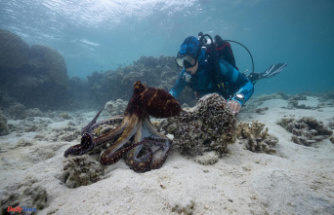the corpse of The little 10-year-old was found in a cemetery that, in principle, welcomed the skeletal remains of babies and children up to 3 years of age.
The mysterious sarcophagus of granite of Alexandria kept the mummies of two men and a woman
A team of archaeologists from the University of Arizona and Stanford University, with the help of Italian archaeologists, have found the remains of a child with a stone in the mouth in an Italian cemetery of the century V. The explanation that they give to this event is that the corpse was the object of a funeral ritual, known as "burial of a vampire". According to their beliefs, the child could get up like a zombie and be able to spread the malaria that caused the death. For that reason, buried in this way.
The discovery of this unusual 'burial of vampires' was conducted during the summer in the commune of Lugnano in Teverina, in the Umbria region in italy, where the archaeologist of the University of Arizona, David Soren, he has overseen the archaeological excavations since 1987. "I had never seen anything like it. It is extremely strange," said Soren, a professor in the School of Anthropology at the UA and in the Department of Religious Studies and Classics. "At the local level, call it the 'Vampire of Lugnano".
The Necropoli dei Bambini or a cemetery for babies is the place where you made such finding, located in the mid-fifth century when an outbreak of malaria deadly struck the area, killing a multitude of babies and small children vulnerable. The bodies of the young victims were buried at the site of a roman villa abandoned, which was originally built at the end of the first century bc.
Until now, archaeologists believed that the cemetery was designed specifically for babies, young children, and fetuses in utero; in advanced excavation of more than 50 burials, a girl of 3 years old was the oldest that was found.
The discovery of the child of 10 years, whose age was determined in function of dental development but whose sex is unknown, suggests that the cemetery could also have been used for older children, explains the bioarqueólogo Jordan Wilson, a phd student in anthropology at the UA, which examined the skeletal remains in Italy. "There are still sections of the cemetery that we have not yet excavated, so we do not know if we will find other older children," Wilson said.
The director of the excavation, David Pickel, indicates that the discovery can inform researchers a lot more about the devastating malaria epidemic that struck the Umbria region for almost 1,500 years, as well as the response of the community.
The remains of a 10-year old boy in a cemetery of the fifth Century, Lugnano in Teverina (Italy) David Pickel"Given the age of this child and its deposition only, with the stone placed inside your mouth, it represents, at this moment, an anomaly within a cemetery that is already abnormal," said Pickel. "This only highlights what is unique is the cemetery children of Lugnano".
In excavations prior in the Cemetery of the Infants, the archaeologists found bones of infants and young children, along with items such as claws of crows, the bones of toads, cauldrons of bronze filled with ashes and the remains of cubs that appear to have been killed, all objects commonly associated with witchcraft and magic.
in Addition, the body of the girl of 3 years had stones that weighed the hands and feet, a practice used by different cultures throughout history to keep the dead in their graves.
"we Know that the romans were very concerned about this and even they would arrive at the end of using witchcraft to prevent the evil, whatever pollutes the body, get out," said Soren.
The "bad", in the case of infants and small children discovered in Lugnano, was the malaria, thought Soren. Tests AND several of the bones excavated, supported his theory.
Although the remains of the creature of 10 years have not yet been submitted to a test of AND, had a tooth abscess (a side effect of malaria), which suggests that it might also have been a victim of the disease, according to Wilson.
The child was one of the five burials new discovered in the cemetery during the summer. The body was found lying on his left side in a makeshift grave created by two large tiles propped up against a wall, a burial-style 'alla cappuccina' typical of Italy in the roman.
Date Of Update: 31 October 2018, 07:00











